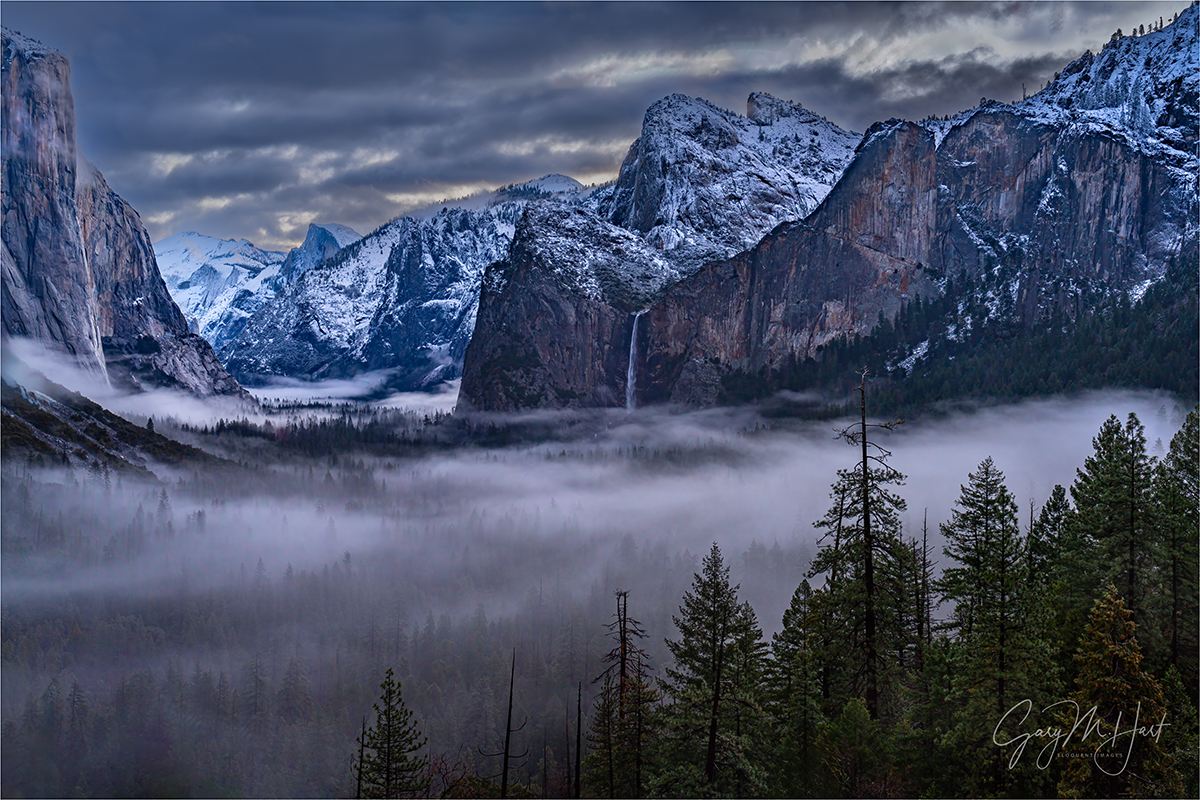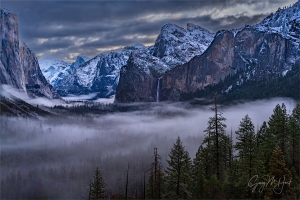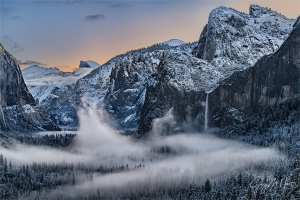Eloquent Images by Gary Hart
Insight, information, and inspiration for the inquisitive nature photographer
Happy Earth Day
My commitment for this blog is one image/post per week. With a workshop that started Sunday and ended Wednesday, I’m a little behind this week, but I made it! Next week I have a workshop that goes from Monday through Thursday, and the following week I’ll be completely off the grid rafting the Grand Canyon. But one way or the other, I’ll continue with my once per week commitment, even if I’m a little late. And if I do have to skip a week, I’ll catch up eventually, I promise. I return you now to your regular programming…
Happy Earth Day to you
How did you celebrate Earth Day (April 22) this year? I was fortunate enough to celebrate up close and personal, guiding a workshop group around Yosemite. It’s easy to appreciate a planet when you’re surrounded by some of its most exquisite beauty, and with a group of people who appreciates it as much as you do, but every time I visit, I’m reminded that we may in fact be loving our wonders to death.
It’s impossible to have zero impact on the natural world. Every day, even if we never leave the house, we consume energy that, directly or indirectly, pollutes the atmosphere and contributes the greenhouse gases that warm our planet. The problem only worsens when we venture outdoors. Our vehicles belch exhaust, or consume electricity that was the product of invasive mining. At our destination, the clothing we wear introduces microscopic, non-indiginous flora and fauna, while the noise we create clashes with the natural sounds that comfort others and communicate information to animals. Even foot travel, the oldest, most fundamental mode of transportation, crushes rocks, plants, and small creatures with each footfall. And let’s not forget the artificial light that dilutes our once black night sky.
I’m not suggesting that we all hole up beneath a rock. If everyone just considered how their actions impact the environment and acted responsibly, our planet would be a better, more sustainable place.
Let’s get specific
The damage that’s an unavoidable consequence of keeping the natural world accessible to all is a tightrope our National Park Service does an excellent job navigating. With their EVs, organic, and recycling mindset, it’s even easy for individuals to believe that the problem is everyone else.
I mean, who’d have thought merely walking on “dirt” could impact the ecosystem for tens or hundreds of years? But before straying off the trail for that unique perspective of Delicate Arch, check out this admonition from Arches National Park. And Hawaii’s black sand beaches may appear unique and enduring, but the next time you consider scooping a sample to share with friends back on the mainland, know that Hawaii’s black sand is a finite, ephemeral phenomenon that will be replaced with “conventional” white sand as soon as its volcanic source is tapped–as evidenced by the direct correlation between the islands with the most black sands beaches and the islands with the most recent volcanic activity.
Sadly, it’s Earth’s most beautiful locations that suffer most. Yosemite’s beauty is no secret—to keep it beautiful, the National Park Service has been forced to implement a reservation system to keep the crowds (marginally) manageable. Similar crowd curtailment restrictions are in place, or being strongly considered, at other national parks. And while the reservations have helped in Yosemite and elsewhere, the shear volume of visitors who make it through guarantees too much traffic, garbage, noise, and too many boots on the ground.
While Yosemite’s durable granite may lull visitors into environmental complacency, it is now permanently scarred by decades of irresponsible climbing. And Yosemite’s fragile meadows and wetlands, home many plants and insects that are an integral part of the natural balance that makes Yosemite unique, suffer from each footstep to the point than some are now off-limits.
A few years ago, so many people crowded the elevated bank of the Merced River to photograph Horsetail Fall’s sunset show, the riverbank collapsed—that area is now off limits during Horsetail season. Despite all this, I can’t tell you how often I see people in Yosemite cavalierly trampling meadows to get in position for a shot, as a trail shortcut, or to stalk a frightened animal.
Don’t be this person
Despite the damage inflicted by the sheer volume of garden variety tourists, my biggest concern is the much smaller cohort doing a disproportionate amount of damage: photographers. Chasing the very subjects they put at risk, photographers have a vested interest and should know better. But as the urge to top the one another grows, more photographers seem to be abusing nature in ways that at best betrays their ignorance of the damage they’re doing, and at worst reveals their startling indifference to the fragility of the very subjects that inspire them to click their shutters in the first place.
If I can’t appeal to your environmental conscience, consider that simply wandering about with a camera and/or tripod labels you, “Photographer.” In that role you represent the entire photography community: when you do harm as Photographer, most observers (the general public and outdoor decision makers) simply apply the Photographer label and lump all of us, even the responsible majority, into the same offending group.
Like it or not, one photographer’s indiscretion affects the way every photographer is perceived, and potentially brings about restrictions that directly or indirectly impact all of us. So if you like fences, permits, and rules, just keep going wherever you want to go, whenever you want to go there.
It’s not that difficult
Environmental responsibility doesn’t require joining Greenpeace or dropping off the grid (not that there’s anything wrong with that). Simply taking a few minutes to understand natural concerns specific to whatever area you visit is a good place to start. Most public lands have websites with information they’d love you to read before visiting. And most park officials are more than happy to share literature on the topic (you might in fact find useful information right there in that stack of papers you jammed into your car’s center console as you drove away from the entrance station).
Most national parks have non-profit advocacy organizations that do much more than advocate, maintaining trails and underwriting park improvements that would otherwise be impossible. For example, the Yosemite Conservancy funded Bridalveil Fall’s recently completed (significant) upgrade that included new flush toilets (yay!), new trails and vistas, and enhanced handicapped access.
If you spend a lot of time at a national park, consider supporting its non-profit partner. The two I belong to are Yosemite Conservancy and Grand Canyon Conservancy.
Develop a “leave no trace” mindset
Whether or not you contribute with your wallet, you can still act responsibly in the field. Stay on established trails whenever possible, and always think before advancing by training yourself to anticipate each future step with the understanding of its impact. Believe it or not, this isn’t a particularly difficult habit to form. Whenever you see trash, please pick it up, even if it isn’t yours. And don’t be shy about gently reminding (educating) other photographers whose actions risk soiling the reputation for all of us.
A few years ago, as a condition of my national parks’ workshop permits, I was guided to The Center for Outdoor Ethics and their “Leave No Trace” initiative. There’s great information here–much of it is just plain common sense, but I guarantee you’ll learn things too.
Armed with this mindset, go forth and enjoy nature–but please save some for the rest of us.
About this image
When I started taking pictures, long before the dawn of digital, my emphasis was outdoor subjects ranging from natural landscapes to urban skylines and bridges. But as my eye and overall relationship with the world has evolved, I’ve gravitated naturally toward landscapes and away from the cityscapes.
I understand now that this evolution has much to do with my love (and concern) for the natural world, both the beauty that surrounds us and damage we’re doing, and a desire to honor it. In recent years I’ve very consciously striven to, as much as possible, create images that allow people to imagine our planet untouched by humans—perhaps hoping that they’ll understand what’s at risk somehow do their share to stem the tide.
Though only number six on the current list of most visited national parks, Yosemite needs to cram the vast majority of its nearly 4-million annual visitors into the less-than 10 square miles of Yosemite Valley. In fact, for more than half the year, almost all of the park outside of Yosemite Valley is smothered in snow and closed to vehicles. This creates congestion and other problems that are unique to Yosemite.
One of the most beloved vistas on Earth, Tunnel View attracts gawkers like cats to a can-opener—all I have to say about that is, “Meow.” Despite its popularity, and the fact that the vista has indeed been crafted by the NPS (paved parking, enclosed by a low stone wall, and many trees removed to maintain the view), Tunnel View remains one of my favorite places to imagine a world without human interference.
My history with Tunnel View in Yosemite dates back to long before I ever picked up a camera, but I never take it for granted. Each time I visit, I try picture Yosemite before paintings, photographs, and word of mouth eliminated the possibility for utter surprise and awe, and what it must have been like to round a corner or crest a rise to see Yosemite Valley unfolding before you (earlier views of Yosemite were not at the current location of Tunnel View, but the overall view and experience were similar).
Today, unless I’m there for a moonrise, I rarely take out my camera at Tunnel View, preferring instead to watch the reaction of other visitors—either my workshop students or just random tourists. But every once in a while, the scene is too beautiful to resist. That happened twice for me in February, when I added two more to my (arguably already too full) Tunnel View portfolio: today’s image and the one I shared last week.
This week’s image came in the first workshop, before sunrise following an overnight rain. Though the compositions are similar, the moods of the two images are completely different. First, in last week’s image, the valley sported a thin glaze of snow, while the overnight temperatures for this week’s image weren’t quite cold enough to turn the rain to snow in Yosemite Valley (though we did find some had fallen on the east side of the valley).
But to me the biggest difference between the two images is the mood. In the snowy image I shared last week, the storm had moved on and the sky had cleared—most of the remaining clouds were local, radiating from the valley floor. The warm light of the approaching sun coloring the sky gives the scene a brighter, more uplifting feel.
The new image I share this week came during a break in the storm, but not at its end. With more rain to come, the moisture-laden sky darkened and cooled the scene, creating a brooding atmosphere. I especially like these scenes for the way they convey the timeless, prehistoric feel I seek.



































That RAINBOW!!!